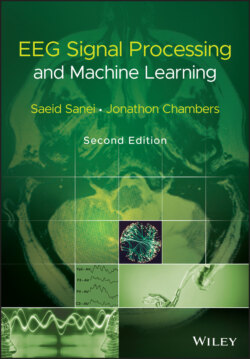Читать книгу EEG Signal Processing and Machine Learning - Saeid Sanei - Страница 27
2.3 Sleep
ОглавлениеBrain waves change during the various stages of normal sleep. When sleep starts the high‐frequency waveforms gradually die away and continuous slow waves (in the delta band) followed by spindles and K‐complexes appear from stage two of sleep and extend towards stage four. During the last stages of sleep rapid eye movement (REM) starts and finishes before the person wakes up. All these stages can be observed and accurately detected and scored automatically by analyzing the EEG signals during normal sleep.
Figure 2.11 A set of normal EEG signals affected by an eye‐blinking artefact.
Conversely, there are cases where the subject has sleep disorder. These include obstructive sleep apnoea (OSA), insomnia (including parainsomnia and hyperinsomnia), REM sleep behaviour disorder, circadian rhythm sleep disorders, non‐24‐hour sleep–wake disorder, periodic limb movement disorder (PLMD), shift work sleep disorder, narcolepsy. Sleep disorders need to be diagnosed and treated.
Such disorders are often detected, monitored, or diagnosed through other recording modalities such as heartrate and respiration. Nevertheless, the use of sleep EEG in detection or monitoring of abnormal sleep has been a topic of research recently. Some methods are discussed in the related chapter of this book.
Figure 2.12 A multichannel EEG set with the clear appearance of ECG signals over the electrodes in the occipital region.
